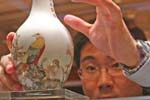Specials
Welcoming the rabbit
Updated: 2011-01-28 13:20
(China Daily European Weekly)
Philippines
Blend of Buddhism with Spanish Catholic mores
By Kitty Go
'Four hundred years in a convent (as a Spanish colony) and 50 years in Hollywood (as an American colony)." This popular quote sums up Philippine culture, which also embraces the Chinese, who were there trading all along the way before the 15th century when the Spaniards arrived.
There is a Chinese belief with Buddhist origins that lighting incense in the new year brings luck and blessings. But the Philippine Chinese take it a step "holier" by combining Buddhism with the Spanish Catholic custom of visiting churches.
"Some Chinese also do a kind of visita iglesia (meaning church visit). They go to several temples on new year's eve, offer incense and pray for blessings," says Ari Dy, a Catholic priest with the Society of Jesus.
The Chinese, who are born and raised in the Philippines, are locally called Chinoys (a slang combining the words "Chino" for Chinese and "Pinoy" for Philippine people in Tagalog). The Chinoys celebrate the Chinese New Year with a big meal, which includes noodles (symbolizing long life) and a whole fish (signifying prosperity). Other traditions include ancestral worship and distribution of ang pao or red packets. Tikoy or sweet sticky rice cakes are eaten and given as gifts. Philippine people, in fact, expect these from their Chinoy friends.
Chinese New Year is not a public holiday in the Philippines but Chinese schools celebrate it with cultural celebrations. The Jesuit-run Catholic Xavier School, one of the country's most prestigious high schools, conducts a mass in Mandarin, and organizes a program of Chinese arts and performances. The school is decorated with Chinese lanterns in the shape of pineapples. "The Hokkien term for pineapple sounds the same as 'prosperity will come'," explains Dy. Hokkien is a dialect spoken by most Philippine Chinese.
Things are changing in this country, from dragon dances in Chinatowns to big celebrations sponsored by businesses and sanctioned by the government. Tulay Digest, a fortnightly community newspaper says there will be an exhibition on Chinese-Philippine relations in Manila's Mall of Asia by Bahay Tsinoy Museum. The event includes a photo exhibition on Jiangsu province.
Tayabas town in central Philippines organizes a Catholic mass, an address by its mayor, a historical talk and exhibition, language tutorials, fireworks, dances and Chinese movies. All these are to honor the first four Chinese families of settlers. Northern city of Baguio organizes a parade in which prominent Chinese people and government officials take part.
"Due to a combination of factors such as the rise of China, including the popularity of all things Chinese in the media, Chinese-ness has become much more mainstream," Dy says. "There is even a bill moved in Congress to declare the lunar new year a public holiday. Things are a lot different from the days when it was an all-Chinese affair only. Chinese new year is now a public celebration in the Philippines," Dy says.
Kitty Go is a Tokyo-based writer for China Daily Asia Weekly.
Specials

Share your China stories!
Foreign readers are invited to share your China stories.

Art auctions
China accounted for 33% of global fine art sales.

Waiting for drivers' seat
Lack of sponsorship appears to be why Chinese drivers have yet to race in a Formula 1 event